Jamie Todd Rubin's Blog, page 8
December 20, 2024
Carl Sagan Day
Photo by Pixabay on Pexels.com
" data-medium-file="https://i0.wp.com/jamierubin.net/wp-c..." data-large-file="https://i0.wp.com/jamierubin.net/wp-c..." src="https://i0.wp.com/jamierubin.net/wp-c..." alt="gray and black galaxy wallpaper" class="wp-image-25660" srcset="https://i0.wp.com/jamierubin.net/wp-c... 1812w, https://i0.wp.com/jamierubin.net/wp-c... 400w, https://i0.wp.com/jamierubin.net/wp-c... 550w, https://i0.wp.com/jamierubin.net/wp-c... 768w, https://i0.wp.com/jamierubin.net/wp-c... 1536w, https://i0.wp.com/jamierubin.net/wp-c... 1200w, https://i0.wp.com/jamierubin.net/wp-c... 1800w" sizes="(max-width: 900px) 100vw, 900px" />Photo by Pixabay on Pexels.comOn December 22, 1996, I left work early to do some holiday shopping at the Northridge Fashion Center. Among the things I bought was a new book for myself: The Demon-Haunted World: Science as a Candle in the Dark by Carl Sagan. I bought the book, according to my diary, because “I read about it in a recent SCI-AM article.” I was in the middle of James Morrow’s This is the Way the World Ends, at the time, and wasn’t really making progress, so I set it aside and read the new Sagan book instead.
A day later, on December 23, I was taken by the book that when I got into work the next day, I excitedly told a friend about it. In reply he said, “You know Carl Sagan died a few days ago.” I was devestated. I’d read one other book by Sagan sometime in the early 1990s before I started keeping a list of my reading. I’m pretty sure it was The Cosmic Connection. The Demon-Haunted World was the final (and 45th) book I read in 1996.
I went on a Carl Sagan binge after that, something I frequently do when I discover a writer I really enjoy. In rapid succession, I read The Dragons of Eden, Broca’s Brain, and Pale Blue Dot. Later, I read the rest of Sagan’s book that I hadn’t read.
Earlier this fall, I re-read Contact, after watching the movie with my youngest daughter, Ellie, who wants to be an astronomer. I also re-read The Demon-Haunted World and Billions and Billions after that.
I mention all this because when I woke up this morning, I noticed the date and something about it seemed familiar to me. It took a few minutes before it hit me. December 20, 1996 was the day that Carl Sagan died–or what I think of as Carl Sagan Day.
He lives on through his book of course, and in the COMSOS series, and countless YouTube videos. But I can’t forget how I felt when my friend told me that Carl Sagan had died.
Did you enjoy this post?
If so, consider subscribing to the blog using the form below or clicking on the button below to follow the blog. And consider telling a friend about it. Already a reader or subscriber to the blog? Thanks for reading!
December 19, 2024
Spoiler Alert

I am of two minds when it comes to spoilers. As a reader, an audience member watching a film, or a middle-aged adult playing a video game—I’m not particularly bothered by spoilers. For me, a story is about the journey, not the destination. The notion of spoiler alerts seems to turn this around. Spoilers are either about the destination or waypoints on the journey to the destination.
As a creator, I understand the delicate crafting that goes into storytelling—a kind of house of cards that has to meet the audience in just the right way to have its desired effect. Whether or not I pull off that effect is as much up to the audience as it is to me, and I don’t worry about it too much.
In my experience, spoiler alerts didn’t exist in the days before the Internet. I remember going to see Return of the Jedi when it first came out and coming home to tell my brother all about it in great detail, including what happens at the end. My brother didn’t seem disappointed by my revelation; my telling made him even more eager to see the movie. But the Internet acts as a kind of informational gravitational lens, magnifying the potential audience of the spoiler. Perhaps there are some people who don’t want to know.
Spoiler alerts seem far more common in works of fiction than in nonfiction—with the possible exception of “shocking revelations” that appear in memoirs or tell-all books. This makes sense. It comes as no shock, when reading a biography of Lincoln, to discover that (spoiler alert!) Lincoln dies in the end. And yet, it is the very idea that a good story can draw us in even when we know the ending that has stayed with me. Knowing that Lincoln dies in the end in no way spoils a biography of Lincoln for me. Recently, I read Doris Kearns Goodwin’s An Unfinished Love Story, a book whose very title is a spoiler alert. And, though I knew the ending, I still enjoyed the book.
There are works of fiction that I have read multiple times. I’ve read Isaac Asimov’s entire Foundation series at least four times. I’ve read Stephen King’s 11/22/63 seven times. Each reading gets better, despite having read the book before. Knowing what happens does not spoil the experience for me.
Ah, but what about that first time? It is true that there is something wonderful about reading a book—particularly a very good book—for the first time, getting lost in something new. But I’m not sure knowing something about what happens ahead of time alters the newness of a book, at least to a degree that would spoil it for me. People describe things I haven’t done all the time, and once I’ve done them, I don’t find the experience diminished. At least, not because of what someone told me ahead of time.
There is a corollary to a spoiler alert that does bother me: it is when someone wants to know what happens before it happens. Kelly is notorious for watching a TV show or film and saying to me, “What happens? Does he live?” Asking for the spoiler seems subversive to the creator in me. Because of this, I avoid spoiler alerts in my writing—not because I think they spoil, but because I think they subvert. They are shortcuts on a larger journey, and it is the journey that is the best part.
Did you enjoy this post?
If so, consider subscribing to the blog using the form below or clicking on the button below to follow the blog. And consider telling a friend about it. Already a reader or subscriber to the blog? Thanks for reading!
December 17, 2024
Upcoming Reading in 2025
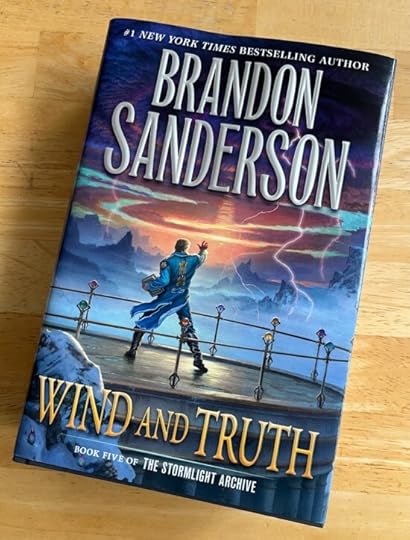
Updates here have been too few and far between. I’ve recently completed the first phase of a major personal software development project (more details to come) and with that major effort behind me, I see the possibility of more frequent updates coming in 2025. In the meantime, I thank everyone who has stuck around despite the quiet desolation here.
With the end of the year approaching, I figured there were two things I could write about: (1) my best reads of the year, and (2) some upcoming reading in 2025. I’m going to hold off on #1 for now because my best read could come on the last day of the year–one never knows. It annoys me to no end when big outlets start listing their best books of the year in November. All those authors who have the misfortune of having their books late in the year only to be overlooked.
For example, I just this morning finished Doris Kearns Goodwin’s An Unfinished Love Story and though it was the 85th book I’d read this year, I immediately added it to the list of “best reads.” There are 8 books on that list now, and room for two more. I arbitrarily limit the list to 10 because I aim to read 100 books each year and I consider the best to be in the top 10 percent. I won’t read 100 books this year, the first time since 2021, but I read many long books so it turns out to be at least the equilvalent of 100 books.
Indeed, upon finishing Goodwin’s book this morning, I debated between two alternatives: Max Boot’s Reagan: His Life and Legend or Brandon Sanderson’s Wind and Truth. I opted for the latter because of the other book I am currently reading: Michel de Montaigne’s Complete Essays. Boot’s Reagan and Montaigne’s Essays seemed like a lot of heavy ready for what is after all a holiday season. Even though Wind and Truth, at 1330 pages is really just a few pages longer than Montaigne’s Essays (1283p), it is lighter fare. My reading almanac predicts I’ll finish Wind and Truth on December 29, leaving the possibility of squeezing in one more book before the year is out. Here are some of the books I have queued up on my nightstand and in my Audible downloads:
Reagan: His Life and Legend by Max Boot. I already mentioned this one. The Glory and the Dream: A Narrative History of America, 1932-1972 by William Manchester. I loved Manchester’s biography of Winston Churchill. He was a supporting character in Goodwin’s recent book and when I read about someone interesting, it often sends me on a search for what else they’ve written. This one looked fascinating, a kind of compliment to David Halberstam’s The Fifties . Nonviolent Communication by Marshall Reosenberg, Ph.D. This one was mentioned in a WIRED interview/profile of Satya Nadella, C.E.O. of Microsoft. The Anxious Generation by Jonathan Haidt, because I’m curious. How to Know a Person by David Brooks. I’ve read Brooks’ columns for a long time, and I was especially fascinated by his recent essay in the December 2024 issue of the Atlantic, “How the Ivy League Broke America.” What It Is Like to Be a Bat by Thomas Nagel, a famous short book that is a kind of pre-cursor to AI.In addition, there are two books for upcoming book club meetings (January and February) that I have on the list:
Autobipgraphy of a Face by Lucy Grealy. Karla’s Choice by Nick Harkaway. This one is going to require me to refresh my memory by rereading The Spy Who Came In From the Cold and Tinker, Tailor, Soldier, SpyOther possibilities include:
Abe: Abraham Lincoln and His Time by David S. Reynolds. Lincoln by David Herbert Donald — because one can never read enough about Lincoln. Miracles and Wonder: The Historical Mystery of Jesus by Elaine Pagels Mark Twain by Ron Chernow Papyrus: The Invention of Books in the Ancient World by Irene VallejoOf course, any one of these books can send me off in other directions–the butterfly effect of reading. But this is what things look like right now. If anyone has recommendations or suggestions, I love to hear them. Leave a comment!
Stay-tuned on our about January 1 for my best reads of 2024. And more to come in 2025.
Did you enjoy this post?
If so, consider subscribing to the blog using the form below or clicking on the button below to follow the blog. And consider telling a friend about it. Already a reader or subscriber to the blog? Thanks for reading!
November 18, 2024
Blue Skies Smiling at Me
Photo by Pixabay on Pexels.com
" data-medium-file="https://i0.wp.com/jamierubin.net/wp-c..." data-large-file="https://i0.wp.com/jamierubin.net/wp-c..." src="https://i0.wp.com/jamierubin.net/wp-c..." alt="blue skies" class="wp-image-25569" srcset="https://i0.wp.com/jamierubin.net/wp-c... 1733w, https://i0.wp.com/jamierubin.net/wp-c... 400w, https://i0.wp.com/jamierubin.net/wp-c... 550w, https://i0.wp.com/jamierubin.net/wp-c... 768w, https://i0.wp.com/jamierubin.net/wp-c... 1536w, https://i0.wp.com/jamierubin.net/wp-c... 1200w, https://i0.wp.com/jamierubin.net/wp-c... 800w, https://i0.wp.com/jamierubin.net/wp-c... 600w, https://i0.wp.com/jamierubin.net/wp-c... 200w" sizes="(max-width: 900px) 100vw, 900px" />Photo by Pixabay on Pexels.comI haven’t been active on social media much the last few years, but when I post here on the blog, the posts are automatically pushed to Twitter (X). I’m moving off X to Blue Sky and so future posts will be relayed there. For those interested, here is my Blue Sky profile: https://bsky.app/profile/jamietoddrubin.bsky.social.
Also: I know I haven’t been posting much lately, but I am trying to work my way back to some regular (interval to-be-determined) writing here. Thanks for your patience and thanks to those of you who have stuck around.
Did you enjoy this post?
If so, consider subscribing to the blog using the form below or clicking on the button below to follow the blog. And consider telling a friend about it. Already a reader or subscriber to the blog? Thanks for reading!
September 8, 2024
Archiving My Blog Posts in Obsidian
Lately, I have been working on a series of small archiving projects. I have been gathering 35 years of digital data, and organizing it locally, mostly in Obsidian. I’m working toward a single, text-based archive that can serve as the source of a personal LLM that will take over the role of traditional search. I want to be able to converse with an LLM about everything and anything I have ever produced. Archiving is a first step in that process.
My most recent venture was to archive into Obsidian all of the blog posts I’ve written over the last 19+ years. I did this in two discrete steps:
Generate markdown files from the WordPress export of my blog.Replace any markdown links to other blog posts with Obsidian-style linksAfter my cleaning process, which included de-duping posts (some early posts were duplicated as part of a migration that happened 16 years ago), the archive stands, as of this writing, at 6,982 posts, totaling 2,936,072 words. Give me the benefit of the doubt and let’s call it 7,000 posts and 3 million words to keep things simple.
Step 1 in my archiving process converted the posts to markdown and also organized the posts into subfolders by year. It also added YAML front-matter to each post containing a title, URL where it appears, and the date the post was originally published. The URL in particular was important for Step 2 to work.
Step 2 went through all of the posts looking for markdown-style links. It built a library of front-matter, mapping the original URL to the archive markdown filename. It then whittled the links down to those that just referenced other posts (as opposed to “external” links) and converted the links within those posts to Obsidian style links. This allowed me to see the connections between all 7,000 of my posts. The results are interesting.
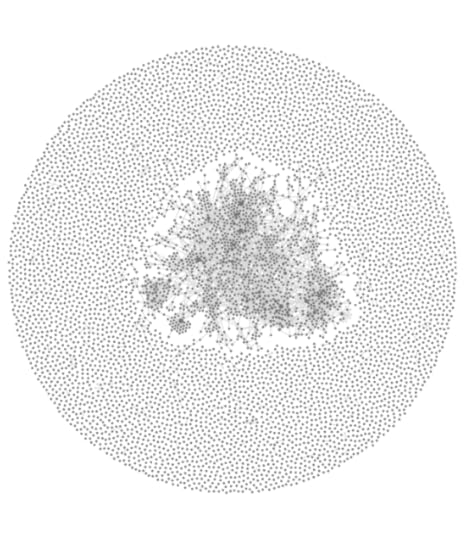 Obsidian graph of my blog posts.There are a total 15,366 links in my blog posts.Of those, about a third (just over 5,000) are links to other posts I’ve written.The remaining two-thirds are links to other sites.
Obsidian graph of my blog posts.There are a total 15,366 links in my blog posts.Of those, about a third (just over 5,000) are links to other posts I’ve written.The remaining two-thirds are links to other sites.Above is the graph of just the 7,000 blog posts in my Obsidian vault, and within that graph you can see the posts that link to one other. If we zoom in, you can begin to see clusters within the linked posts, a few of which I have identified below:
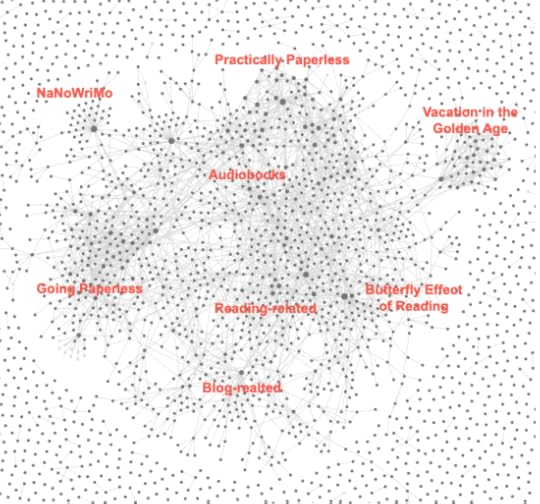
Out of curiosity, I took a look at those 15,000 total links across all 7,000 posts. I was curious about the most-frequent domains I linked to. Here is a chart showing the top 10 domain I’ve linked to over the years by the number of links:
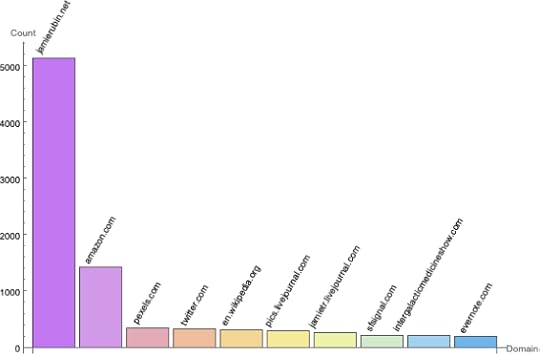
If I take out internal references to my own blog, the chart looks like this:
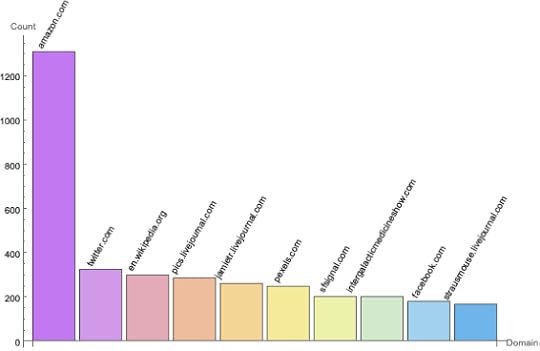
Searching is much faster in Obsidian than in WordPress, and I can use complex searches like regular expressions.
I imagine a few people will have questions about the technical aspect of how I did this. In early 2023, I mentioned that I was consolidating all of my coding into Wolfram Language, in part because I like the idea of a purely symbolic language, and in part because I wanted to learn something entirely new. As I said at the time:
I’ve been a very casual, hobbyist user of Mathematica for years now. But the more I play with it, and the more I learn about its symbolic and functional structure, the more impressed I am with the language. Moreover, the language now reaches into all aspects of computing so that it seems useful as a general purpose language. Finally, as a developer, I’ve already mastered more common languages like Python, JavaScript, C#, Perl, PHP, Ruby, etc., to my personal satisfaction. Becoming equally proficient in Wolfram Language would something new.
In the nearly 2 years since writing that, I have written countless Wolfram Langauge scripts, and while by no means an expert, I’ve become fairly proficient. One nice thing about Wolfram Language is it makes dealing with AI, machine learning, and LLMs fairly simple and straightforward (as much as such things can be) so it makes for more seamless integration with my ultimately goal of being able to search my archive using an LLM.
What’s next? I’ve got thousands of handwritten diary pages that I am archiving. I originally thought this would be a project for retirement, but after some experimentation, I’ve discovered that GPT-4o is a wiz at taking images of handwritten pages and almost flawlessly transcribing them into markdown format. It works just as flawlessly on pages that I have written in cursive as it does pages that I have printed. The biggest hurdle is the labor involved in taking photos of the thousands of pages. Fortunately, my daughters have agreed to help me with that task. Stay-tuned.
Did you enjoy this post?
If so, consider subscribing to the blog using the form below or clicking on the button below to follow the blog. And consider telling a friend about it. Already a reader or subscriber to the blog? Thanks for reading!
August 6, 2024
Flying Lessons of Life
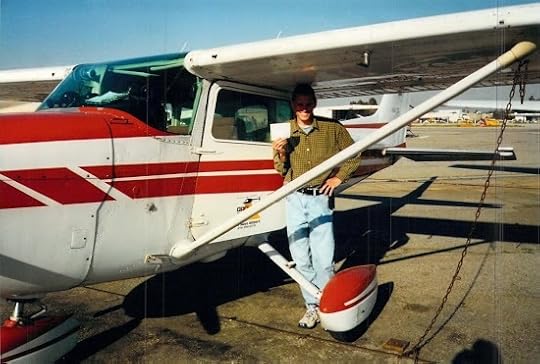 Me with my temporary private license on the day I passed by checkride ride.
Me with my temporary private license on the day I passed by checkride ride.I took my first flying lesson two days before John F. Kennedy, Jr. and Carolyn Bessette-Kennedy were killed when their plane crashed off Martha’s Vineyard. I described that first flight in my diary as follows:
We got into the Cessna 152 with me in the pilot’s seat and made a flight around the local area. It was awesome! We flow south out of Van Nuys, over the Santa Monica mountains. We then headed out over Malibu, then Calabasas, Simi Valley, Newhall, and back to Van Nuys. It was about 100 miles and I logged 0.8 hours of tach time.
It took me nine months to get my private license. After that, I flew for another 15 months, finally giving it up shortly after 9/11 when it become amore complicated to fly in the increasingly restricted airspace above greater Los Angeles. There are times when I miss it, when I wish I had kept it up. I imagine making our semi-annual pilgrimages to Florida or Maine in a Cessna rather than the minivan. On the other hand there are some life lessons I’ve taken from my flying days that have served me in good stead ever since.
Situational AwarenessI’d never heard the term “situational awareness” until I began taking flying lessons. The concept is important for flying because there is a lot of things that can require your attention as a pilot, and it is important to have a sense of the big picture. Taking off, for instance, you are talking to air traffic control, while climbing out, ensuring proper pitch of the aircraft, looking out for other aircraft, and keeping an eye on the instruments to make sure everything is in the green.
The idea of situational awareness had an almost immediate impact on me. It changed the way I drove around town, for instance. I was in my twenties, and often in a hurry, but after I started taking flying lessons, I slowed down, I was more cautious about my surroundings (is there a car in my blind spot? I should check before cutting across the lanes) and better attuned to the other drivers on the road.
Aviate, Navigate, CommunicateWhen flying an airplane, there is an order of precedence with which a pilot will prioritize their tasks: keep the plane flying (aviate); get the plane to where it is going (navigate); and talk to air traffic control (communicate). I’ve found this to be a useful adage for life in general, and my co-workers, especially, have heard this from me now and then. During some critical system failure, or attempting to fix a software bug ad hoc, you get a lot of people coming to your (now virtual) door. My typical response is to focus on the task at hand–getting the immediate problem solved, or aviating. When the bleeding has been stopped, I’ll look ahead at longer-term fixes (navigating). Finally, when I’ve got things stabilized, I’ll update Jira tickets, and send email status updates–communicating.
Occasionally, people are miffed by this approach until I explain it to them. I could spend time up from updating Jira tickets and sending out emails about what I think the problem is or what we intend to do to fix it, but that just prolongs the fix. Just like flying an airplane, the first job is to keep it flying, stabilize things, make sure you are heading in the right direction, and then let people know what’s going on.
(This sounds more complicated than it is. When flying, this typically arises in a situation like this: I’m lined up for runway 16R with a moderate crosswind. A few miles from the runway, the tower calls, “73-echo, can you switch to 16L for traffic?” at which point, I might respond, “Standby…” while I see if I can slip the plane over while managing the wind and keeping the nose aligned with the runway. Once that is done, I’ll reply, “We can do 16L, 73-echo.”)
Keep It Simple, SillyWhen designing software, reports, writing stories, or even blog posts, I try to keep in mind another adage I learned when flying: keep it simple, silly. I’ve lost track of how many times I’ve been in meetings with folks who want some kind of dashboard. They give me long lists of gadgets and charts and visualizations they want on the dashboard that will help them keep track of their business. I sit through these patiently, and when they have finished describing what they are looking for, I tell them the same story:
In good weather, a pilot really only needs 6 instruments to fly the plane: airspeed, altitude, attitude, vertical speed, turn-and-bank, and heading. With those 6 instruments, on a clear day, you are in good shape.
What, I ask these folks, are your six instruments? On a typical day, what are the six pieces of information you need to know to keep things running smoothly? By the way, it can be fewer than six, but let’s not make it any more. Chances are no one is going to look at all of them anyway.
Even writing a blog post, I’ll complete a draft, look at it, and say to myself, there’s more than six instruments in there. No one is going to know what to look at? How can I simplify this. Often this results in a complete rewrite.
Recently, I obtained a copy of the latest version of Microsoft Flight Simulator for Xbox. I was amazed at how far that had come from when I first played around with it in the 1980s. I sat in the “Xbox room” with my son, setup a flight out of Van Nuys airport in a Cessna 172, set the difficulty at “realistic” or the equivalent, and then attempted to fly a pattern. I was successful, and I think my son was impressed by how smooth the landing was. It had been a long time, more than twenty years. Maybe it was just a case of beginner’s luck.
Did you enjoy this post?
If so, consider subscribing to the blog using the form below or clicking on the button below to follow the blog. And consider telling a friend about it. Already a reader or subscriber to the blog? Thanks for reading!
August 5, 2024
A Pilgrimage to John von Neumann’s Birthplace
We were in Europe recently for a few weeks, and spent a few days in the beautiful city of Budapest, Hungary, a city rich in history. Our hotel was directly across the river from the neo-Gothic Hungarian Parliament building, a building I could stare for hours, if I had the time1. There was much to see in Budapest, and we had only a few days to pack it all in. But there was one thing I wanted to see, one special pilgrimage I wanted to make: find the birthplace of John von Neumann.
When traveling in other cities, my morning walks continue unabated. I rise early, no matter the time zone, and head out, usually without a plan, to wander the streets of a city sleeping. I love passing through cities like this, away from the traffic and crowds, with time to look at what I am seeing and consider it. We were in Europe for 17 days and with the exception of our very last day, when we had a 6am flight, I wandered the city I was in every morning.
My first morning in Budapest was different from all of the other cities, however. I had a plan. We were on a tour and had gotten to know some of our fellow tourists. Some would ask me, “Are you heading out to walk the city in the morning?” and I responded by telling them I was getting up earlier than usual to seek out John von Neumann’s birthplace.
“Who is that?” was the unanimous reply. Even our tour director, an encyclopedia of knowledge about the places we visited, said that he didn’t know who that was. That was depressing, especially considering how much von Neumann shaped our modern life. You could look him up on Wikipedia, but even better would be to read Ananyo Bhattacharya excellent biography, Man From the Future: The Visionary Life of John von Neumann (2022). von Neumann was a prodigy, mathematician, physicist, and computer scientist who worked on the Manhattan Project, helped to pioneer game theory2, and helped invent the modern computer.
I headed out of the hotel at 5:30am on July 23 for what turned out to be a nearly 6.5 kilometer (when in Europe, use the metric system) roundtrip walk. I walked across the bridge on the southern end of Margaret Island and continued into the quiet city streets. At some point, I turned right off the main road into a narrow street where I walked for a few blocks until I turned left, and finally I reached the building where John von Neumann was born and lived until he was 18 years old.
 John von Neumann’s birthplace.
John von Neumann’s birthplace. The plaque honoring von Neumann on the side of the building.
The plaque honoring von Neumann on the side of the building.When I walk through these cities early in the morning, I try to absorb their history, what came before, and how things might have looked, and smelled, and felt back then. I stepped across the street from the building to take a photo. I was standing in a place where von Neumann almost certainly passed each day he lived here. This was building von Neumann lived where, at six years old, he was conversant in ancient Greek, and where, a few years later, he was doing calculus.
I lingered for as long as I could, taking it all in, trying to see von Neumann walking into and out of his building. But I had a long way to walk back, and I decided that rather than retrace my route, I’d make a big circle, I navigated toward the Parliament building and south toward the Chain Bridge. I took the pedestrian route across the bridge, and then followed the river back to my hotel, glowing a feeling genuine achievement: I’d made my pilgrimage to John von Neumann’s birth place.
 Crossing the Chain Bridge
Crossing the Chain BridgeDid you enjoy this post?
If so, consider subscribing to the blog using the form below or clicking on the button below to follow the blog. And consider telling a friend about it. Already a reader or subscriber to the blog? Thanks for reading!
August 4, 2024
The Familiar Strangers of Bluemont Junction
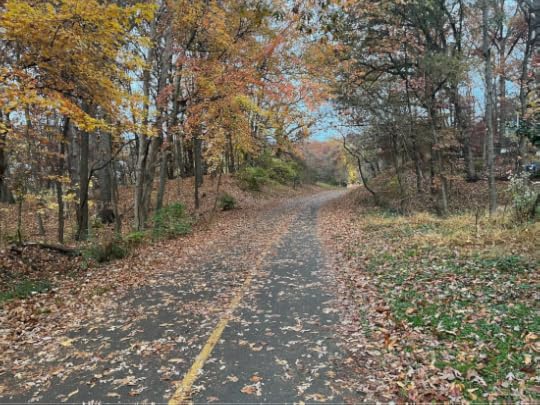
Twice a day I take a two-and-a-half mile walk through the Bluemont Junction part of my town. I walk from our house down to the park and then follow the bike paths along what is known locally as the Bluemont Junction trail. Sometimes, I stop at a local 7-Eleven for a soft drink or a newspaper. Sometimes I simply turn around and head home. I make this walk in the cool of the morning, the heat of the day, in darkness in the winter, and before sunrise in the early summer. I walk when it is raining or snowing, when I am tired, and even when I am not feeling well.
Since moving into this house more than five years ago, I’ve probably walked this route more than 3,500 times. Usually, I am listening to a book as I walk, but one can’t walk a route day after day for years on end without noticing the company one passes. The people of Bluemont Junction have become a familiar sight to me and, I suppose, I to them, though I know very few names.
There is Neal, for instance, an 88-year old fellow who is frequently out walking early. He is tall, slightly stooped, and with a handlebar mustache and more than a passing resemblance to Sam Elliot. A year or so ago, I didn’t see him for a while, and I’d return from my walks brooding about what might have happened to him. Then, one day he was back, using a walker. Turns out he’d fallen and broken a hip, and despite being (then) eighty-seven, he completed his physical therapy early and was back out walking. I saw him yesterday, and he no longer uses a walker or a cane, he just walks slowly. Sometimes, he whistles and that whistling carries along the long, narrow strip of park that the bike path divides. Usually, I’ll stop and chat with him for a while.
I’m usually out before sunrise, and in the winter, I walk in the dark, and on most days, I see the same early birds. There is an old fellow, who drives his car to the park, and then walks the bike paths. He is short with a wind-worn face, and a gravelly voice with a strong accent. He always says, “Good morning!” cheerfully, and I always reply.
There is an older couple who speed walk, and who I usually cross paths with early in my walk. The woman almost always walks ahead of man, sometimes as much as 50 yards ahead. The man always gives me a big small and wave and I wave back. We usually pass each other a second time on my way back and go through the entire routine again, perhaps with more of a smile on our lips, each of us wondering about the protocol of waving a second time. This morning, for the first time in memory, I saw them walking together, side-by-side.
There are lots of runners, some of whom I can now tell just by their gait and pace. One fellow is usually heading back toward our neighborhood early in the morning, running just as fast at the end of his journey as I’ve seen him running at the start. He doesn’t even seem winded. Another woman, rail thin, runs with long strides, with a look of determination on her face, as though this time she is going to set some personal record, although I see that look on her face every morning she passes me.
There is another fellow who walks with a pronounced limp, who always lifts his hand slightly and nods when we pass. We pass each other frequently without a word. One day, I was sitting in the McDonald’s near my turnaround point, having some breakfast, and he came up me, said hello, and shook my hand.
Quite a few people are out walking their dogs. I know the name of only one of them–the dogs, that is–Brownie. His owner takes him down to the nature trails and tosses frisbees for him to catch. Another dog catches frisbees on a strip of park that runs parallel to the bike path. Many of the dogs are as familiar to me at this point as the people.
Early Sunday mornings are usually the quietest, the mornings on which I see the fewest people. There have been Sunday mornings on which I haven’t seen another soul. If I get the time just right, I’ll walk back and pass a group people coming up the bike path, holding crosses and rosaries, and singing. They turn off the bike path and head up one of the side-streets toward a local church. This morning–a Sunday–I was surprised by how many people were out, although admittedly, I slept in a bit and didn’t hit the trail until about 6:15am. I sometimes pick up a copy of the Sunday New York Times, but I was out of luck this morning, too early for the paper at both 7-Eleven and Safeway.
In addition to the people, there are the animals, beyond the dogs, that I encounter on these walks. Deer are frequently on the trail, or just off to the side, and are used to people walking by. They don’t budge. I see foxes crisscross the trail here and there. Birds are ever-present, but early in the morning I hear owls, and occasionally, catch a glimpse of a large wingspan passing through the trees. Frogs sing along the banks of the stream that runs through the park. Ducks paddle their way about the stream. “My ducks,” I call them, and if someone is with me, I’ll look at them ruefully and say, “Don’t they look delicious?” Once, I got a video of an otter making its way up the stream.
There is a comfort to this walk. The people are strangers and yet familiar. They smile, they nod hello, they wave. They populate the little world of the Bluemont Junction bike path and make my daily walks more pleasant.
Did you enjoy this post?
If so, consider subscribing to the blog using the form below or clicking on the button below to follow the blog. And consider telling a friend about it. Already a reader or subscriber to the blog? Thanks for reading!
May 29, 2024
What I’ve Learned from Three Decades of Writing
Photo by Steve Johnson on Pexels.com
" data-medium-file="https://i0.wp.com/jamierubin.net/wp-c..." data-large-file="https://i0.wp.com/jamierubin.net/wp-c..." src="https://i0.wp.com/jamierubin.net/wp-c..." alt="focus photo of yellow paper near trash can" class="wp-image-25102" srcset="https://i0.wp.com/jamierubin.net/wp-c... 1880w, https://i0.wp.com/jamierubin.net/wp-c... 400w, https://i0.wp.com/jamierubin.net/wp-c... 550w, https://i0.wp.com/jamierubin.net/wp-c... 768w, https://i0.wp.com/jamierubin.net/wp-c... 1536w, https://i0.wp.com/jamierubin.net/wp-c... 1200w, https://i0.wp.com/jamierubin.net/wp-c... 1800w" sizes="(max-width: 900px) 100vw, 900px" data-recalc-dims="1" />Photo by Steve Johnson on Pexels.com“Give me any random idea and I can write a story from it.”
This is how I used to think of myself back when I first started to write with an eye toward selling stories. I was twenty years old, and up to that point, the ability to write, such as it was, was the only visible talent I could muster. Or perhaps not the only talent. I had a bit of ego to go along with it, something I’d heard was a necessary ingredient to one who thought enough of their craft that people would be willing to pay to read it.
Some people are slow learners, and in the classroom of writers, I just may be among the slowest. It took more than three decades of writing and the occasional story sale, to teach me lessons that I probably could have learned in a year, had I been more focused, had less ego, and been more open to discovery about myself. I’m not sure even now, as I write this, that I have fully grasped those lessons, but I have learned things along the way about writing and about myself. Let me tell you a story.
In late December 2023, while on holiday in Florida, I happened upon an article that described a goal matrix that Shohei Ohtani, the major league baseball phenom, created when he was only 17 years old. This matrix centered around 9 areas and had the goal of being drafted first in the MLB draft. I was impressed by this and thought I could use a similar matrix to jump start my writing. I set myself a goal of writing 100 stories over the next 7 years, or so–about 1 story per month. Why 100 stories? Because every story is practice and practice helps to improve the craft. I was never prolific with my fiction writing and I figured if I could write 100 stories, that would be all the practice I’d need to hone my skills to the level I knew they could reach. I used the Ohtani’s model to build up support structure for achieving that goal. Here is my matrix:
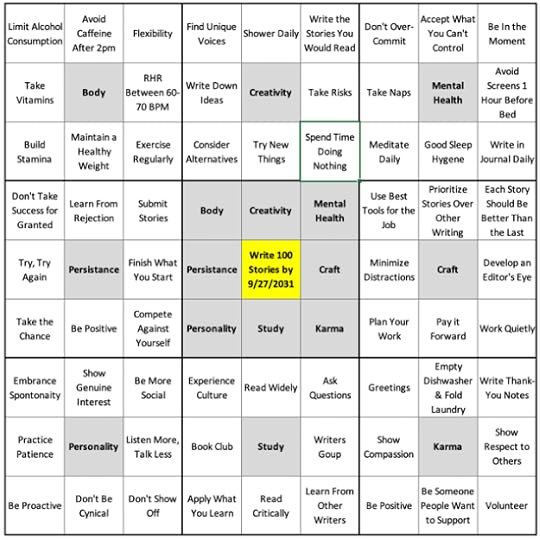 My goal matrix as it was on December 27, 2023
My goal matrix as it was on December 27, 2023January 2024 would be the month for Story #1. To meet my goal I needed to complete a first and a second draft of a story but I didn’t need to take it beyond that if I didn’t want to. That meant I needed a story idea. “Give me any random idea and I can find a story from it.” It just to happened that I had an idea for a story that never worked out, but sitting on the lanai in the warm Florida winter, it occurred to me that the problem with my idea was that it was too big. If I narrowed the scope of it, I could work very well. All of the sudden the idea caught fire. I could see the scenes as clear as day. It took all my effort to hold off writing until January 1. When the New Year rolled around, I begin to write the story. By January 5 I’d completed the first draft. By January 11, I had my second draft, and it wasn’t even halfway through the month. The story almost wrote itself. I spent January 12 and 13 doing some edits and the story was finished. A few days later, on January 18, I started the next story. By February 21, that story had gone nowhere and I knew the goal I’d set myself was a ridiculously silly one. I stopped writing entirely.
I stopped writing, but I didn’t stop thinking about writing. Why didn’t the second story work? It was a decent idea, so what was wrong? After all, give me any random idea and I can make a story from it, right?
More than thirty years of writing has changed my view of this. I can probably write a story from any random idea, but rarely could I write a good story from any random idea. Why not? It turns out that not all ideas are equal. Some are better than others. This would seem like an obvious lesson for a writer to learn fairly early on, but it is a difficult lesson to see with an ego blocking your view. I see it now, though, plain as day. Not all ideas are equal, and for me at least, it doesn’t make sense to waste energy on a lesser idea just to say that I wrote a story about it. With all of the talent I can muster, I’m just not capable of turning a lesser idea into a great story.
How to I know if an idea is good? This is hard to describe because it is instinct. There is a feeling I get when an idea takes hold of me. The idea consumes me. I get excited about it. I pace around my office, sitting, standing, impatient to start writing. The idea is a spark that ignites furnace inside me and I can’t stop until the fuel has burned itself out. This sounds vague, I know, but it is one of those “I know it when I feel it” kind of emotions. Looking back, my most successful stories came from these kinds of ideas. I suspect part of the reason that the very first stories I wrote when I was getting start are so embarrassingly bad in retrospect is not because I lacked talent, but because I lacked a filter for ideas. I wrote stories for every idea I had.
The story I wrote back in January came from a good idea. The furnace burned hot when I wrote it. Ultimately, it because the first story I’ve submitted to a magazine in over a decade. The next story I tried writing was not a particularly good idea and it was therefore doomed from the start. It took me longer to see that, but when I did, and I considered it, I began to see that I’d been thinking about how I go about writing stories almost from the beginning.
While I might be someone who can write a story for any random idea, I cannot write a good story for any random idea. I need a good idea. And while I am rarely at a loss for a story idea (I’ve accumulated so many over the decades that I could live the rest of my lift without ever having a new idea and still have plenty to write), I am not one who frequently has a good story idea. Ego and impatience have conspired against me in this regard. Good ideas come when they come. This is just the way my mind works. They may not come frequently, but they always come, and accepting this has changed the way I think about writing.
There have been other lessons. I’ve always felt the need to track what I write. I’m fascinated by the process of constructing a story. I frequently imagine my favorite authors, sitting in their offices, tapping away at a keyboard, or scribbling on a legal pad. How do they construct stories. And since they are so successful, shouldn’t that mean that if I follow their recipe, I’ll be successful, too. I track my writing so that I can go back and reconstruct what worked and what didn’t. In reality, I’ve probably spent two or three times the amount of time, effort, and creativity on the tracking and the infrastructure, than on the creative act. I’d built elaborate templates, I’d write scripts to automate things, always telling myself that these activities will allow me more time to write, and always spending more and more time perfecting these systems and not writing. I did this even in college, in the early 1990s, creating macros in Microsoft Word for DOS 5.5 to help track my writing. I’ve been doing it for more than 30 years.
Recently, I asked myself why and I didn’t have a good answer. In the past I’ve told myself that I’ve done this to learn about my process: I can go back and see the evolution of a story from idea, to draft, to final draft, to acceptance, to publication and then, like some digital archeologist, dig through my files and discern what I did to make this particular story successful. But in thinking hard about this, I finally saw the two flaws that I’d overlooked all along. First, every story is different and what works in one case doesn’t necessary work in the other. Second: I have never gone back to dig through the history of a story to see what worked or what didn’t. This is one of those ideas that seems good in theory, and is never used in practice.
For a long time I was focused on regimenting my time. I’d work out calendars to ensure that I had time set aside to write each day, and then, when that window came, whether I was ready or not, I’d sit down to write. It was often painful. It took decades for me to learn this, but for me, the creative spark comes when it comes, and I can’t summon it at will, as much as I wish I could.
If I could go back in time and do it all over again, I probably wouldn’t change anything. I know myself well enough to know that I have to learn things in a certain way for them to finally settle in and stick. However, if I were to go forward taking the three decades of lessons I’ve learned from writing, I’d alter my approach in several ways.
I’d curate good ideas. I’d rather be able to say, “Give me a good idea and I’m much more likely to produce an interesting story.”I’d be patient and not stress when well was dry. Decades have shown me that it always fills up again. It’s just a matter of time.I’d write when the mood hit me and for as little or as long as I wanted, wherever I happened to be.I’d eschew all formal infrastructure; I’d no longer worry about tracking my work; I’d open up a document in Microsoft Word and begin typing.It’s been more than four months since the well ran dry, and that feels like a long time, but experience has taught me it always fills up again. And so it has. I’m writing again. I’ve what I think is a good idea that I’m excited about. I’m writing when the mood strikes me, and I’m not worrying about tracking my work.
I’m just having fun.
Did you enjoy this post?
If so, consider subscribing to the blog using the form below or clicking on the button below to follow the blog. And consider telling a friend about it. Already a reader or subscriber to the blog? Thanks for reading!
May 19, 2024
The Persistence of Memory
Photo by Pixabay on Pexels.com
" data-medium-file="https://i0.wp.com/jamierubin.net/wp-c..." data-large-file="https://i0.wp.com/jamierubin.net/wp-c..." src="https://i0.wp.com/jamierubin.net/wp-c..." alt="blue notebook on red surface" class="wp-image-25050" srcset="https://i0.wp.com/jamierubin.net/wp-c... 1880w, https://i0.wp.com/jamierubin.net/wp-c... 400w, https://i0.wp.com/jamierubin.net/wp-c... 550w, https://i0.wp.com/jamierubin.net/wp-c... 768w, https://i0.wp.com/jamierubin.net/wp-c... 1536w, https://i0.wp.com/jamierubin.net/wp-c... 1200w, https://i0.wp.com/jamierubin.net/wp-c... 1800w" sizes="(max-width: 900px) 100vw, 900px" data-recalc-dims="1" />Photo by Pixabay on Pexels.comWhen I first started keeping a diary, I did it mostly out of imitation. Isaac Asimov kept one, and I liked the idea. As he wrote, “I began with the intention of recording everything of significance each day. As time went on, however… my diary became a kind of compact literary and social record of my life.” He went on: “The diaries are a series of reference books, for me, a way of finding out when something happened and in exactly what order things happen1.” Memory, you see, is fallible. These arguments convinced me to start a diary in April 1996, which means I’ve been keeping the diary in one form or another for 28 years. Today, I wish I’d started keeping it much sooner.
I try to remember this each time I sit down to update my diary. I find myself frequently starting a day’s entry with the words, “Up at 5:30am after a (good / fair / poor) night’s sleep…” When I flip through the entries, many of them are dry accounts of my day. Over the last few years, I’ve tried to be more expressive, using the diary to argue, to debate, to ponder, and to just get stuff out of my head so that I don’t have to think about it, and yet safe in the knowledge that it is recorded somewhere. Yesterday, however, I was reminded of another reason why I keep the diary, and the value it has for me.
It rained most of the day and I felt antsy because I didn’t get out on my usual early morning walk. A break in the rain came around 9am, however, and I dashed out for an extended walk before the spigot was turned back out. Usually, I listen to a book while I walk (currently, Oranges by John McPhee), but yesterday I happened to be listening to Sirius XM’s “80s on 8” top 40 countdown for this week in 1982. I was 8 years old at the beginning of the decade and 18 when the decade ended. The music of that era forms the soundtrack to an important part of my life growing up. Music is a kind of memory-enhancer for me. Just as I can recall where I was when I read any particular book, when I hear song, it brings back clear, powerful memories. In the late spring of 1982, I was a few months past 10 years old, and living in Warwick, Rhode Island. As I walked, the songs I heard conjured memories I’d hadn’t thought about in decades.
For example, when Joan Jett’s cover of “Crimson and Clover” came on, I remembered suddenly, that I had a ’45 that had “I Love Rock-n-Roll” on one side, and “Crimson and Clover” on the opposite side. I remember that I loved the former and didn’t think much of the latter. But the thought of that album–which I’d completely forgotten about–put me in mind of my bedroom in that house in Warwick. The house was a raised ranch, and my bedroom was in southeast corner, with a window facing south over the driveway, and east over the front yard. If I tried hard, I could picture the room in a vague way. I could see where the beds were located. I could see the closet door on the north wall by east-facing window. I remembered staring at the closet door for hours the night after coming home from seeing Poltergeist in the theater. My bed was on the south wall and my brother’s bed was on the north wall. But the vision is blurred, as if looking at it through smoked glass.
How is it that I could live in that house for four years — 1,500 days! — and my memory of it be so blurry. For that matter, how is it that I can’t recall the details of any given day? I can remember, even as far back as when I lived in Somerset, New Jersey, laying in bed to take a nap, five years old perhaps, and thinking thoughts like, “When I am ten years old, I should remember this day when I was just five and wishing I was ten.” In later years, I’d lay in bed, staring at a dark ceiling and think, “When I’m fifty,” — in some inconceivably distant future — “I should remember the time when I was 15 laying here in bed, and thinking about all the years that separate these two people.”
Too many of those years are obscured by dark glass. I don’t think it is that I have forgotten, so much as I have lost the references to the place where those memories are stored. Music, in that sense, is a kind index to my memory. My diary is another index and that is its real value. Just as hearing Joan Jett conjured images of my childhood bedroom, my diary serves an index to the memory of my life. Considered in this light, I don’t feel bad about diary entries that begin by reminding me that I am an early riser. I’ve tried more and more to make the diary as broad in index as I can. Where I used to write things like, “Spent the afternoon at the pool club with the Edgertons,” I now try to be more specific, providing at least the skeleton of conversations we had, topics we discussed. Memory indices fade and I figure the more detail I provide, the more chance a future version of my will skim a page, and quickly recall the scene therein.
I suppose, in some sense, my diary is the closest I can come to backing up the index of my memory, a kind of database transaction log that can be replayed at any point. I think this is the real reason why I keep updating my diary with mundane details and brilliant insights alike. It is imperfect, but more persistent than my own memory will likely be. When I flip through the diary to a random day, I’ve forgotten most of the details of that day until I read them. Once read the, the memories come flooding back, the details fill in.
Memory is imperfect to begin with. By writing about my day on that day when events are fresh in my memory, I get them down as accurately as I can manage. Of course, there is certainly some bias that slips in. Perception itself is a kind of bias. I’m okay with that. It is the Rashoman effect. Someone reading an entry of a particular day may remember the events of that day differently from what I remembered. Usually the differences are small and meaningless, except that perhaps they help describe aspects of the observers’ (mine or theirs) personality.
Besides, my notes and diaries have given me a reputation among friends and family as someone who can answer all kinds of questions. Whether or not they like or agree with the answers my diary provides is another story.
Did you enjoy this post?
If so, consider subscribing to the blog using the form below or clicking on the button below to follow the blog. And consider telling a friend about it. Already a reader or subscriber to the blog? Thanks for reading!



